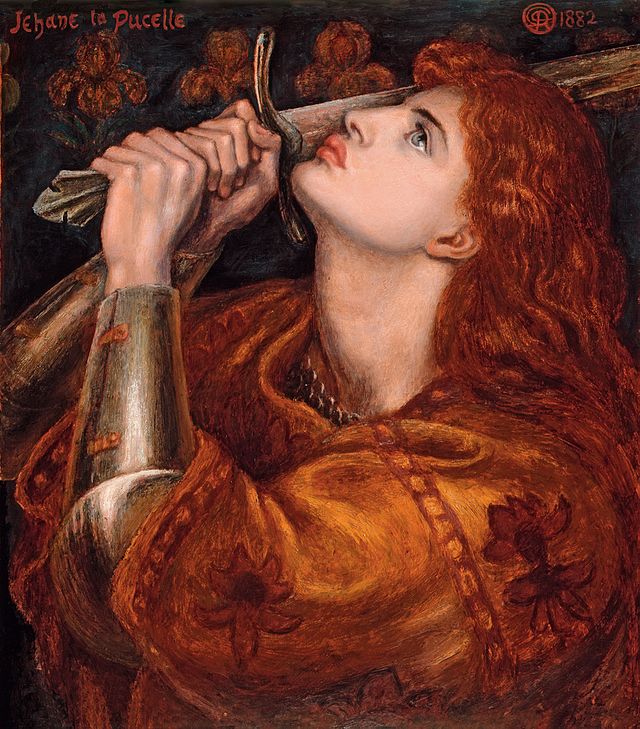Top 13 Interesting Facts About Joan of Arc
Originally published by Natalie on October 2019 and updated by Charity K on August 2022
Joan of Arc, the heroine of France, remains one of the most important women to have ever walked this planet. She was responsible for leading the French army to victory over the English at Orléans, after convincing Charles VII to let her dress like a man and fight.
Why? From the age of 13 she had been receiving communication from archangels St. Michael, St. Catherine of Alexandria and St. Margaret of Antioch; their message being that she would have to help Charles VII become king of France.
Here are ten things you likely didn’t know about this phenomenal woman.
1. Joan of Arc Had Many Names
Prior to her first trial, Joan of Arc noted her name as “Jehanne la Pucelle” meaning Joan the maid, claiming she did not know her last name.
In her hometown of Domrémy, northeastern France, she was known as Jehanette. There are also records of Jehanne d’Arc, Jehanne Tarc, Jehanne Romée and possibly Jehanne de Vouthon.
It is thought that Arc was simply an adaption of her best guess of what her father’s last name might have been: d’Arc.

Joan’s signature – Wikimedia Commons
2. She Has Been Diagnosed With Many Disorders by Today’s Doctors
Because Joan claimed to have been delivered information directly from the archangels, there are many people today who attempt to further understand and diagnose what could have been going on in her brain.
Some believe it to have been neurological imbalance that began as a child, which would eventually result in schizophrenia or bipolar. Others speculate that she could have contracted bovine tuberculosis as a young girl which would cause episodes of dementia later in life.
None suspect Joan was really in communication with the archangels, but there is a large esoteric community who do believe in her ability to receive information from other realms. Most of it is supported by the notion that everything Joan was told would happen, did. She clearly had some sort of outer worldly abilities.
3. She Wasn’t From Anywhere Called Arc
As mentioned, this was merely her way of guessing her own fathers last name. She was in fact from Domrémy, a small village in the northeast.
Today this village in France is called Domrémy-la-Pucelle. It was renamed as an ode to Joan; a Pucelle d’Orléans had been her nickname.
4. She Was the First Woman to Create the “Bob” Haircut
The same voices that told her to don men’s clothing in order to go into battle, also told Joan to wear her hair quite short. She cut it haphazardly into a bob, and it remained in this style until her captors shaved her head shortly before she was executed.
It was later in 1909 when Paris’ most sought after hairstylist, Monsieur Antoine, used Joan of Arc as his inspiration to begin cutting women’s hair into the bob style.
If you follow French fashion trends, you’ll know that the bob is regularly associated to the classic image of a Parisian woman, usually in conjunction with a beret of sorts.
5. Joan of Arc Never Actually Participated in Active Combat
Joan was very much at the forefront of all of the battles, but this was more metaphorically than physically. She created strategies, manned troops and offered solutions, but she never actually engaged in active warfare herself.
She would accompany the troops into battle, but held a banner instead of a weapon. She did, however, sustain two serious injuries on separate instances. One was an arrow to the shoulder and another was a crossbow to the thigh.
6. Contrary to Popular Belief, it was not Witchcraft She was Burned at the Stake For
When Joan was first captured by the English, they charged her with over 70 counts of crime including horse theft and what they called “sorcery”. But over the next few months these were reduced to just 12, and looked as though they would be further lowered.
Amongst these 12 was the unspeakable offense of a woman wearing men’s clothing, as well as talking to archangels.
It is said that one evening the judges visited her in captivity and she had put her male wardrobe back on, and was also claiming the voices were back.
They dubbed her a “relapsed heretic” and for this she was burnt at the stake.
7. Her Burnt Body Was Put on Display
Burning a body takes a lot longer than many of us are probably aware, and after the first round of flames, Joans body was pulled from the coals and put on display. The intent of this was to show any skeptics that she absolutely did not escape, and was indeed burnt.
Her body was then put back into the flames until it had completely disintegrated.
8. Her Brothers Passed an Imposter off as her from 1434 to 1440
In attempt to convince the world that Joan had indeed escaped her captors, and the English had not won, her brothers passed off several imposters as her for a number of years.
The family received lavish gifts from the people of Orléans.

by Magnus Manske – Wikimedia Commons
9. Her Ashes Were Thrown Into the Seine
Tracing history back, it would seem that the remains of Joan at the stake were gathered together and the scattered into the Seine.
There are tales to this day of her spirit still moving with the water, all through the city for the rest of time.
10. It is Thought That Her Dressing Like a Man Helped Her Avoid Rape
When Joan was captive and made the decision one day to put her male wardrobe back on it is thought that it was threats of rape by her guards that made her do so.
The male clothing was a deterrent, and could have helped to make her undesirable to the guards.
11. Joan was Captured by Burgundian Troops and Exchanged for the English

Photo by Wikimedia Commons – Wikimedia
In early 1430, Joan organized a company of volunteers to relieve Compiègne, which had been besieged by the Burgundians. She was captured by Burgundian troops on 23 May and exchanged for the English. She was put on trial by the bishop, Pierre Cauchon, on a charge of heresy.
She was declared guilty and burned at the stake on 30 May 1431, dying at about 19 years of age. In 1456, Pope Callixtus III authorized an inquisitorial court to investigate the original trial. The court nullified the trial’s verdict, declaring it was tainted by deceit and procedural errors, and Joan was exonerated. Since her death, Joan has been popularly revered as a martyr.
After the French Revolution, she became a national symbol of France. She was canonized in 1920 and declared a secondary patron saint of France in 1922. Joan of Arc remains a popular figure in modern literature, painting, sculpture, and music, and cultural depictions of her continue to be created.
12. The Armagnac troops had faith that Joan would bring them to victory

Photo by Wikimedia Commons – Wikimedia
She arrived at Orléans on 29 April 1429. She subsequently met the commander Jean de Dunois, acting head of the ducal family of Orléans on behalf of his captive half-brother. Because Orléans was not completely cut off, Dunois was able to get her into the city, where she was greeted with great enthusiasm.
Initially, Joan was treated as a figurehead to raise morale, flying her banner on the battlefield. However, she was not given any formal command and was excluded from military councils. What was interesting is that Joan quickly gained the faith of the Armagnac troops, who believed she could bring them to victory. Over time, some of the Armagnac commanders would accept the advice she gave them.
On 4 May, the Armagnacs went on the offensive, attacking the outlying bastille de Saint-Loup (fortress of Saint Loup). Joan was not informed of the attack. Once she learned of it, she rode out with her banner to the site of the battle a mile east of Orléans. She arrived just as the Armagnac soldiers were retreating after a failed assault.
Her appearance rallied the soldiers, who launched another assault and took the fortress. On 5 May, no combat occurred since it was Ascension Thursday, a feast day Joan deemed too holy for fighting. Instead, she told a scribe to record a letter to the English warning them to leave France. She had it tied to an arrow that was shot by a crossbowman.
13. Joan was wounded by an arrow but never gave up

Photo by Wikimedia Commons – Wikimedia
The Armagnacs resumed their offensive on 6 May. They captured Saint-Jean-le-Blanc, which the English had deserted. Though the Armagnac commanders wanted to stop, Joan encouraged them to launch an assault against an English fortress built around a monastery called les Augustins. It was successfully captured. After the capture of les Augustins, the Armagnac commanders wanted to consolidate their gains, but Joan again argued for immediate offensive action.
On the morning of 7 May, The Armagnacs attacked the main English stronghold, les Tourelles. Joan was wounded by an arrow between the neck and shoulder while holding her banner in the trench outside the wall on the south bank of the river, but later returned to encourage the final assault that took the fortress. The English retreated from Orléans on 8 May, ending the siege.
At Chinon, Joan had declared that she was sent by God. At Poitiers, when she was asked to show a sign demonstrating this claim, she replied a sign would be given if she were brought to Orléans. The lifting of the siege was interpreted by many people to be that sign including very prominent clergy such as Jacques Gelu, Archbishop of Embrun. In addition, the theologian Jean Gerson wrote treatises in support of Joan immediately following this event. In contrast, the English saw the ability of this peasant girl to defeat their armies as proof she was possessed by the Devil.
Planning a trip to Paris ? Get ready !
These are Amazon’s best-selling travel products that you may need for coming to Paris.
Bookstore
- The best travel book : Rick Steves – Paris 2023 – Learn more here
- Fodor’s Paris 2024 – Learn more here
Travel Gear
- Venture Pal Lightweight Backpack – Learn more here
- Samsonite Winfield 2 28″ Luggage – Learn more here
- Swig Savvy’s Stainless Steel Insulated Water Bottle – Learn more here
Check Amazon’s best-seller list for the most popular travel accessories. We sometimes read this list just to find out what new travel products people are buying.













